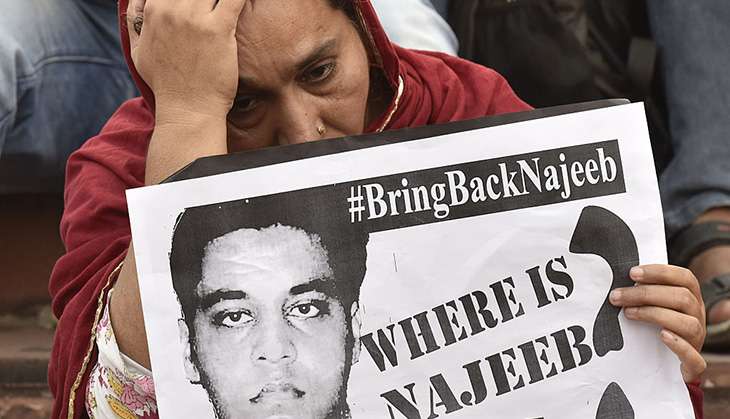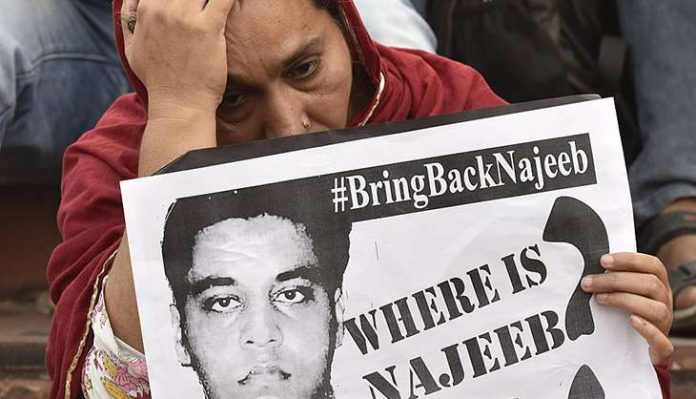By Sharjeel Imam and Saquib Salim for Twocircles.net
Najeeb Ahmad, a first year Masters student of Biotechnology disappeared more than six months ago from the Mahi hostel of JNU. There was an alleged scuffle on the previous night among a few students, after which Najeeb was beaten up by a group of students. The next morning, he went missing.

According to the narrative floated by the AISA-SFI-led JNUSU, after his disappearance, since Najeeb was a Muslim, he was “lynched by a communally charged mob of ABVP goons”. There are three parts of the incident, according to the standard narrative: the alleged scuffle, the ‘mob violence’ and the disappearance. JNUSU president Mohit Pandey reached the spot during the ‘mob violence’, and claimed that he tried to stop the attackers. In the standard narrative, the ABVP ‘goons’ were beating Najeeb, while AISA-SFI led union was trying to stop the violence. Through this narrative, AISA-SFI has projected themselves as the champions of the rights of a beleaguered Muslim minority in the campus.
The gaping holes in the ‘Left’ narrative:
A cursory glance at the facts of the case, however, suggests that AISA-SFI led JNUSU were at least as much of a culprit as ABVP, if not more. In fact, they changed their narrative radically after Najeeb disappeared in order to hide their problematic role in the incidence.
First of all, use of the word ‘lynching’ would fall under the category of fear-mongering which would feed to communalism, which eventually ends up harming the Muslims. The dictionary meaning of the word lynching is “kill for an alleged offense without a legal trial, especially by hanging.” The disappearance of Najeeb is not a case of lynching by any stretch of the imagination.
The other major hole in the narrative is related to the fact that Najeeb was beaten up again even after Mohit Pandey reached the spot. Our question is that if a mob was violently assaulting Najeeb, then why could Mohit and his supporters not stop the violence? If they tried and failed, then why were they not brutally beaten up as well? If Mohit failed to gather even two activists from the largest organisations in his support, that too just a month after winning the election by a huge margin, then shouldn’t he resign from his post immediately? In a hostel wing where a majority of the students are Muslims, is it possible that an anti-Muslim group can beat up one Muslim student because of his faith, and no major confrontation takes place?
The controversial statements of JNUSU office bearers
First of all, the statement signed by Mohit Pandey on the same night mentions that ‘Najeeb, without any provocation, slapped Vikrant in front of two witnesses’. The statement omits the now established fact that Najeeb was beaten up by a group of students. Even more interesting is the statement was given on the same night by Najeeb’s roommate Qasim Dargahi, who is an AISA leader and a JNUSU office-bearer himself. In his letter, he informs the warden that his interactions with Najeeb were limited, as Najeeb has moved into the hostel just a few days ago. It is surprising that, even with this limited interaction, Qasim had the confidence to claim in the statement that Najeeb’s claim of being ‘mentally unsound is false’. He further claimed that he himself ‘felt threatened because of his inappropriate behaviour’ on that night. Even Qasim fails to mention that Najeeb was beaten up, and hence both Qasim and Mohit did not represent Najeeb’s side in front of the warden, and in fact acted against him. Najeeb was eventually asked to vacate the hostel in 6 days.
Both of these JNUSU office bearers, who later appear in a different avatar posing as crusaders for Najeeb’s cause, were clearly blaming only Najeeb on the night of violence. They omitted the crucial detail that Najeeb was the primary victim that night. In fact, if Najeeb had not disappeared, they would have felt no need to communalise the issue by calling it a ‘mob lynching’ of a Muslim student. The hypocrisy of JNUSU is apparent from the pamphlet of 23 October when the same charges are levelled against the VC. The pamphlet says that ‘Najeeb was subjected to brutal violence by ABVP members’. It also notes that the press release from the administration had ‘no mention of the attacks on Najeeb’, and that the administration wanted to paint Najeeb as the prime accused. Both of these charges are valid against Mohit and Qasim as well. In fact, JNUSU pamphlet does not tell us that the administration based its position on the written statements by Mohit and Qasim themselves, and merely repeated what they had written that night. Given this u-turn by JNUSU, it does not come as a surprise that they did not file a complaint on the same night, neither was it interested in seeking a medical report. Najeeb became ‘the only victim’ from the main accused of Mohit-led JNUSU after his disappearance.
Even though JNUSU has a readily available legal opinion and access to leading lawyers, it has failed the victim’s side on this front as well. First of all, JNUSU is not a party to the case. In fact, the habeas corpus petition was not filed within a month. Najeeb disappeared on 15th October, and on 7th November, after it had become a national issue, Justice Markandey Katju posted on Facebook tagging JNUSU leaders, asking them to file a habeas corpus petition. He even offered to help in the process. It is surprising that JNUSU did not get this idea for more than 22 days.
The petition was finally filed by Najeeb’s mother Fatima Nafees on 14th November, only after Justice Katju’s suggestion had been widely reported by the media. All of this suggests that AISA-SFI led JNUSU is either thoroughly incompetent or that they had a sinister plan to gain mileage by politicising the issue. We hope and would like to believe that the leading talking-heads of these parties are not incompetent. Hence we draw the conclusion that the campaign by AISA-SFI led JNUSU is indeed a face-saving exercise of misinformation. By communalising the issue, and talking incessantly about a communally charged ABVP ‘mob’, they want to hide their own negative role in the event. On the other hand, ABVP has displayed its habitual anti-Muslim bigotry by claiming that “Najeeb wished to join ISIS”.
Left’s support on the issue is mere tokenism
The mobilisation for Najeeb’s issue has been limited within the campus. Most of the protests have been led by Student Islamic Organisation, Muslim Student Federation, and other Muslim organisations. AISA-SFI have registered only a token presence in these protests. Contrast it to Kanhaiya’s arrest, where there was a massive outrage both inside as well as outside the campus. Kanhiaya was a political prisoner and was not facing a life-death situation, unlike Najeeb. We have witnessed a lot of u-turns, and displays of fake sympathy from these organisations, whose greatest contribution seems to be the fact that they put Najeeb’s photo as their profile pictures. However, these organisations behave as if they are leading the search for Najeeb by copy-pasting legal updates about the case in mass on social media.
From Najeeb’s perspective, it is not just the assaulting students who are the culprit, the JNUSU president Mohit, and Najeeb’s roommate Qasim who gave statements against him are culprits as well. The largest organisations of the campus (AISA-SFI), which are leading the union with a huge mandate, did not intervene when he was being beaten up, but in fact sided with the attackers, silenced him, lied about the incident, and declared him as the assaulter. It is no surprise that anyone in Najeeb’s circumstances would feel threatened for his life.
The turn of events mentioned above would surprise many, especially those who take the AISA-SFI claim of secularism seriously. However, those who have witnessed their functioning from close quarters, would not be surprised, as they have been long aware of Indian left’s inherent anti-Muslim nature.
The authors are research scholars at Centre for Historical Studies, JNU, and live in the same hostel wing where Najeeb resided.


